
What is uploading?
- Uploading is what is done when files are transferred from
your computer to another computer in a remote location. It's
similar to copying files from one folder to another. When making
web sites, only a limited audience can visit your site unless
you give your creation a home on a computer that others can access
from their machine. If you upload to a computer connected to
the internet, not only do you give your web site a home, but
you give it an address, called a URL (Uniform Resource Locator),
that anyone can reach. When you move files (upload or download)
you will use a protocol known as file transfer protocol (FTP).
What's a server?
- A server is simply a big hard drive that lots of users
can access. Your web site is saved in several places. If you
work on it at home, you probably save your site to your hard
drive. You may try to back it up on a floppy or two, but floppies
don't have the capacity to hold a web site that contains lots
of images. So you may back up your web site on a Zip disk, too.
Most likely, however, your site is saved on the server in the
lab where you meet for this class. Everyone in the class can
save to this server, but no one (we hope) can access this server
from outside the school site where that server is located.
- The internet is a vast collection of connected computers
called web servers. Those web servers can be accessed by anyone
who has permission to do so. You will upload your web site to
a web server, and by doing so, you will give permission to others
to access your material. Only you will have permission to change
your web site, but everyone will be able to see your stuff.
Do I need to choose a server?
- You need to choose the server you want to use. However,
you are fortunate in that you attend CSUS. Colleges and Universities
usually provide free e-mail and web site hosting to their students.
CSUS is no different.
- The Saclink Option: The CSUS
account you can use is called Saclink, and you can get one of
these from University Computing and Communications Services on
campus in the Science building in room 322. You'll get instructions
that show you how to set up your account, and the friendly people
there will also walk you through any problems you may experience.
- Once you sign up, it takes 24 hours for the account to
be established.
- After your account has been established, you need to activate
your web site. That's one of the options you choose as you set
things up. It takes about twenty minutes to log on, read the
disclaimer and set up the site.
- You get a cup of coffee and read the class textbook assignment
for about thirty minutes, and your site is active.
- All the documentation can be obtained from this URL: http://www.csus.edu/uccs/labs
- The Classweb Option: Another
option is to use the Classweb server. If you are in my Problem
Solving and Computers class, I will give you space on that
server.
- The ISP Option: The other
option, is to use a private provider. These are called ISPs (Internet
Service Providers). You pay for this service. The most efficient
provider I have experience with is JPS Net. I tend to direct
students away from large providers like AOL because the uploading
process is much more complicated than what I will show you here.
A few students have reported that AOL uploading services are
becoming much more simple of late.
- I would suggest that you use a combination of all three
options. Having lots of server space is a big deal when you make
websites. It's like pie and ice cream; there's never enough!

What software is necessary?
- There are several pieces of freeware and shareware that
you can use to upload your web site. Click on any of the options
named below to go to the download sites.
- The common software for the Macintosh is called "Fetch"
by Jim Matthews from Dartmouth College. It's free to those connected
with educational institutions and charitable organizations.
- Another very nice piece of FTP software for the Mac is
called "Transmit"
(also referred to as Transit) from Panic Software. You can download
it for free, and if you want to buy it, you pay only $24.95!
Transmit is much easier to use than Fetch in my opinion, but
both are extremely user friendly.
- The most common software for PCs is called "WS_ftp"
from Ipswitch Inc. and it's completely free.
- In this lesson, I'll illustrate using Fetch. Once you
know how to use Fetch, any other set-up will be similar.
Can this be done anywhere?
- Yes, unless there is a firewall that prohibits this procedure
from the lab you're using.
What gets uploaded?
- Everything in your web site folder gets uploaded to the
web server you choose. You will have a directory on the web server.
With Saclink and Classweb, it's called "web". You will
upload all your html files and all your gif and jpg images.

Can I download files, too?
- Absolutely! Anything that can be placed on a web server
can be taken back or deleted. Remember, your files are still
on the hard drive in the lab and probably at home, too. When
you upload and download, files remain on the host computer. You
can think of this process as copying files from one location
to another.
So how do I use FTP?
- This is actually the easy part, but it can be dreaded
by the uninitiated. Here we go!
You will be given a copy of Fetch. Most likely, however,
it will be on the computer you use in the lab. Open Fetch by double
clicking on its icon. You will see a window that looks similar
to this.
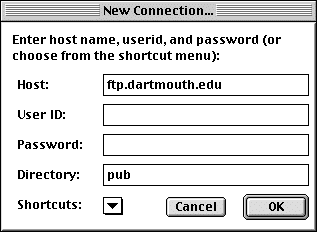
Hit "Cancel" and go to "Customize" =>
"New Shortcut" as you see in the image below.

You will see a window similar to the one below.
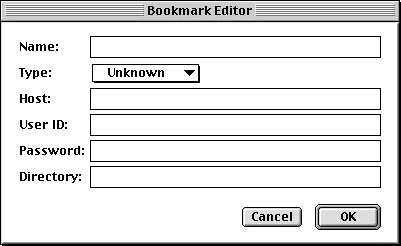
Enter the correct information to make the window similar
to this one if you're configuring Saclink.

Obviously, your User ID will be different than mine. Don't
enter your password because this information is saved on the computer
you're using in the lab at the time.
Enter the correct information to make the window similar
to this one if you're configuring Classweb.
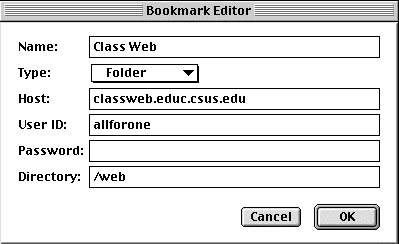

Once you click on OK, you have a shortcut that you can access
from that particular computer. If you use another computer, you'll
need to reconfigure another new shortcut. Since I do most of my
uploading at home, I usually forget the procedure. Lucky for me
I have it written down somewhere!
To actually upload something, all you really do is open
Fetch, cancel the window that opens up first, go to "File"
=> "Open Shortcut" and you'll see your account name
that you entered into the window above. You'll see lots of other
accounts, too. Just ignore them. You only need yours. When you
open your shortcut, you'll see the password window.

Your user name will be at the top (not mine) followed by
@saclink.csus.edu or @classweb.educ.csus.edu.
Enter your password and press return. A window opens with a little
dog that "fetches" your directory on the Saclink or
Classweb server. Here's the directory window
below with the fetch pooch scooting right along!

When the dog stops, you're in your directory. At this point,
you go to "Remote" => "Put Folders and Files"
in the Mac menu bar.


The last window that opens is the one that lets you select
the files you want to upload. It looks like this. When you're
finished adding to the list (double click on the files you want),
click Done! You can drag and drop from your file folders to the
directory window above, too.
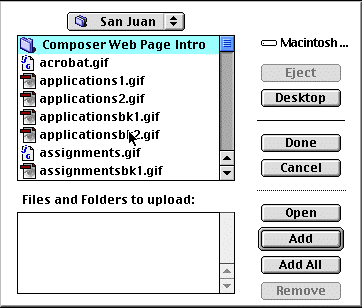
The Window above shows you a portion of my San Juan folder
on my hard drive. The files that I double click will appear in
the little window below that one and upload to one of the CSUS
faculty servers. You will upload hundreds of times! Typically,
when I make a web page, I edit, save, browse
and upload eight or nine times per page. It pays to get
to know this procedure as soon as possible.
On Windows machines, the WS_FTP set-up looks like this:
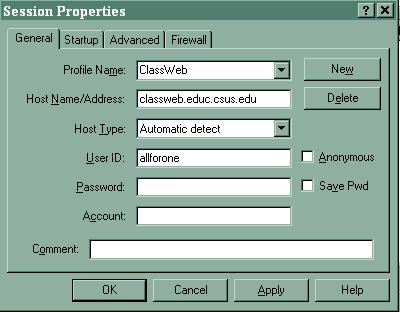
Hit New.
- The Profile name can be anything you want.
- Fill in the Host Name as shown above or use Saclink as
a host name as illustrated in the Fetch window above.
- Type in your User ID that was given to you in class or
by the Saclink clerks.
- Type in your password but don't click on Save Pwd unless
you are on your own computer at home. Otherwise, anyone using
the computer you're using for this procedure can open your account.
- IMPORTANT: At the top of the Session Properties window
is a tab called Startup. Click on that and type /web for your
initial remote host directory.
Hit OK and your new window looks like this:
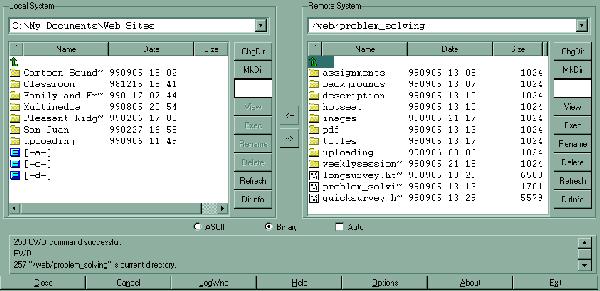
The window on the left is your computer; the one on the
right is the remote server. Select the files or folders in your
hard drive to upload to the server by clicking. Once selected,
click on the arrow that points to the right. Doing the opposite
will download files from the server to your hard drive. Kapeesh?
And finally, if you used Saclink, your URL will be something
like this:
http://webpages.csus.edu/~yourusername/afileyoumade.htm
Classweb URLs will look like this:
http://classweb.educ.csus.edu/~yourusername/afileyoumade.htm
You can send this to anyone in the world who is online,
and they can see what you've done. You can even e-mail it to yourself
if you think you'll forget it!
For advanced web designers: Frames














